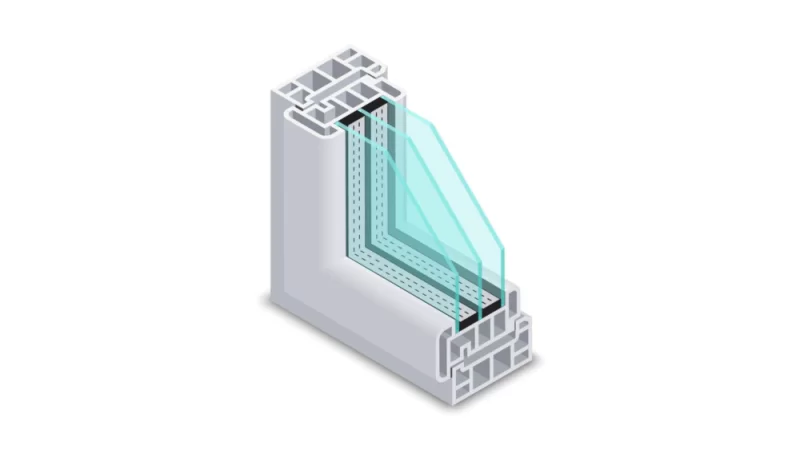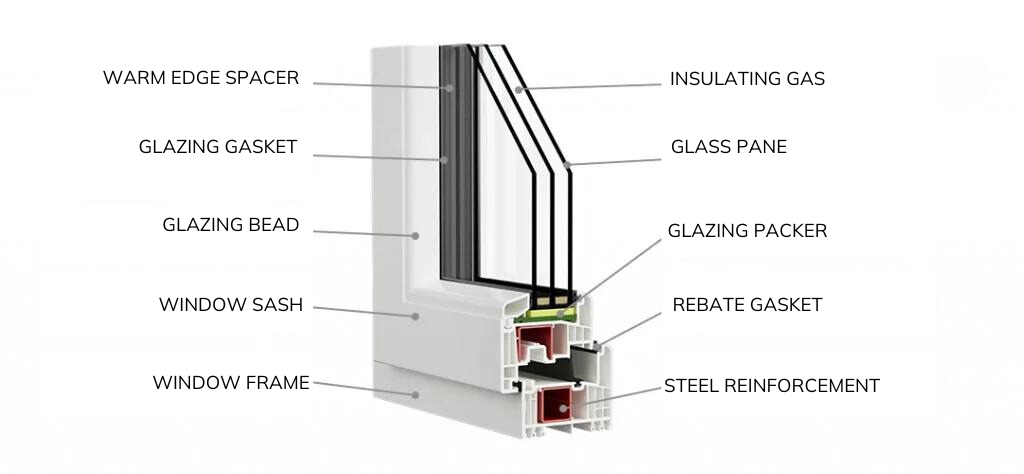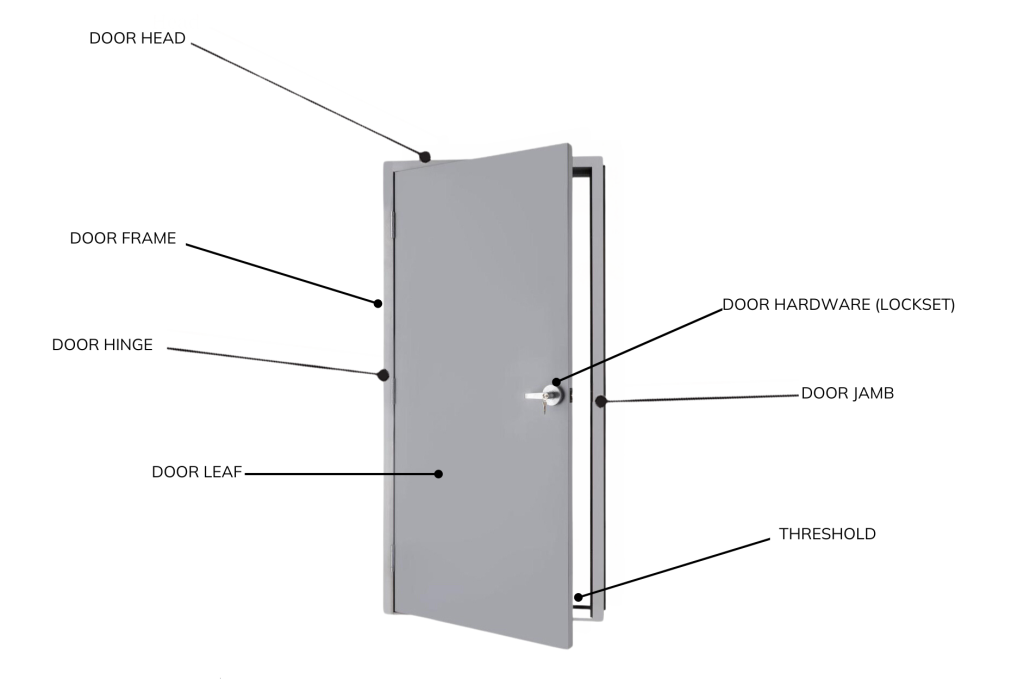Do you know the difference between double-glazing and triple-glazing ? Do you know what elements a window consists of? How to differentiate among Uw, Ug and Uf values? Knowing the correct window and door joinery terminology is one of the first tasks of every window buyer. Why? Well, simply because such knowledge will help you avoid mistakes in the purchasing process and will help you choose the right window and doors for your home. That’s why we have put together a glossary of commonly used joinery terms, especially for Fenbro customers!
The benefits of knowing joinery terminology
As with any specialised field, joinery comes with its own language and joinery names that can be confusing to those who are not familiar with it. The multitude of phrases, parameters and technical markings describing windows and doors may create an incomprehensible and mysterious code, creating a barrier that is difficult to overcome when choosing windows and entrance doors. Obviously, joinery manufacturers, sellers and fitters use advanced joinery terms that may seem like their own specialised language – and it’s important to understand it when you are making a major investment in your home. What for? The answer is easy: in order to be able to communicate well and effectively with your chosen joinery suppliers. And be sure that your money in windows and doors has been properly invested! Here we have collected all the useful joinery terms and created our handy windows and doors glossary. It features some of the most important joinery names and parameters that you are likely to come across in the industry. We hope all of this joinery terminology will prove helpful as you progress through your home renovation or new build project!
Glossary of window terms
- Insulated glazing unit (IGU)
The window unit is made of at least two glass panes separated by a warm edge spacer, sealants and vapour-absorbing substances and sealed together at the edge.
- Double-glazed unit (double-glazing)
An insulated glazing unit consisting of two panes of glass separated by a layer of insulating gas. For example, the description 4/16Ar/4th means that the double glazing unit consists of a 4mm glass pane on the outside, a 16 mm warm edge spacer with Argon gas and a 4mm glass pane on the inside.
- Triple-glazed unit (triple-glazing)
An insulated glazing unit consisting of three panes of glass separated by a layer of insulating gas. For example, the description 4th/18Ar/4/18Ar/4th means that the triple glazing unit consists of 4mm glass on the outside, a 18mm warm edge spacer with Argon gas, another 4 mm of glass, another 18mm warm edge spacer with Argon gas and 4mm glass on the inside.
- Warm edge spacer
A type of a spacer bar used for separating glass panes in double or triple glazing units. Its aim is to insulate the glazing unit and prevent the effect of thermal bridge (no cold areas near the window). Additionally, it stops water vapour forming between the panes of glass, thus eliminating window condensation.
- ESG glass
Tempered/toughened safety glass is made from annealed glass via a thermal tempering process. It is characterised by increased resistance to crushing or breakage. However, if it breaks, it falls apart into small pieces with blunt edges, which minimises the risk of injury.
- VSG glass
Laminated safety glass is made of multiple layers of glass with a foil interlayer in between to hold the panes together. It effectively reduces the risk of burglary or theft. If it breaks, the pieces of the glass stay attached to the foil, helping to avoid injuries to nearby people. The possible VSG glass descriptions: 33.1 – 2 panes of 3 mm each glued with 1 film33.2 – 2 panes of 3 mm each glued with 2 films44.2 – 2 panes of 4 mm each glued with 2 films
- Argon (Ar)
A noble non-toxic gas inserted between the panes of glass to increase the insulating performance of double-glazed and triple-glazed units.
- Krypton (Kr)
A noble non-toxic gas inserted between the panes of glass to increase the insulating performance of double-glazed and triple-glazed units. Krypton gas is denser than Argon gas, which makes it an even more effective insulator.
- Uw (W/m2K)
The window’s heat transfer coefficient. It informs you about the level of window thermal insulation. The Uw (U- value) shows how much heat will penetrate 1 m2 of a window in one hour, with a difference between the temperatures on both sides of the window of one degree. This means that the lower the Uw coefficient, the better the window’s thermal insulation is. This value also incorporates the U-values for the frame (Uf) and the glazing (Ug).
- Uf (W/m2K)
The heat transfer coefficient of the window frame. Its value depends primarily on the frame structure (its width, number of chambers) as well as the use of steel reinforcement in the frame.
- Ug (W/m2K)
The heat transfer coefficient of the glazing. Its value depends on the construction of the glazed unit and the low-emissivity technologies used.
- Acoustic insulation (Rw)
Acoustic insulation coefficient. It determines the insulation of a window or a door against noise from the outside. The unit of measurement is decibels (dB). This parameter is influenced by: the thickness of the glazing in the glazing unit, the use of PVB laminated glass or the use of an acoustic foil.
- Light transmission (LT-value)
The value stated in percent and expressing the amount of light which is admitted through the glass. A high figure indicates a high degree of light transmission.
- Thickness of the glazing unit
A glazing unit is a structure consisting of two, three, or even four panes of glazing separated from each other by a distance frame, sealants and vapour-absorbing gas (argon \ krypton). The thickness of the glazing unit is the overall measurement, from the outside glass surface to the inside glass surface. The average double glazing thickness is about 24 mm while triple-glazed windows are 42 – 48 mm in thickness on average. The number of panes in a glazing unit affects the improvement of the U-value parameter.
- Window frame
The portion of the window that holds the glazing unit and sits between the glazing and the wall of the building when installed. It consists of the head, jamb and sill.
- Frame head
The main horizontal part that forms the top of the window frame
- Frame jambs
The main vertical parts that form the sides of a window frame
- Window sill
The main horizontal structure at the bottom of the frame of a window. It creates an overhang and drip to protect the inside wall and floors from water damage. Window sill also plays an important role in the functionality of the window as it holds the sash in place when the window is closed.
- Window sash
The part of a window that surrounds the glass and holds it in place in the window frame. It can be rectangular or square, movable (opened, closed, or tilted) or fixed. It is designed to allow ventilation and access to the outside but also prevent air leaks and draughts around the window.
- Glazing beads
These window components ensure that the insulated glazing unit (IGU) remains in the window frame. They are generally made from vinyl, aluminium, or wood. They are also known as glazing strips or glazing bars.
- Glazing packer
A window construction accessory used to level up the glazing unit to the correct heights. It ensures the glazing unit is aligned to the frame and stops it from slipping.
- Window muntins
Narrow bars dividing the panes of glass within windows. Glued-on muntin bars are glued to the surface of the glass and perfectly imitate the original form of window muntins. Inside-glazing muntin bars are “hidden” between the glass panes, which makes them a perfect choice for those who prefer easy cleaning and maintenance.
- Depth of the frame
The distance between the window pane and the edge of the window frame. The depth affects the sound insulation, thermal insulation (U-value) and stiffness of the window structure.
- Width of the frame
The width of the frame is measured jamb-to-jamb from the inside of the trim on one side of the window to the inside of the trim on the other side.
- Window chambers
The chambers keep air from circulating and in this way they create an additional insulating layer. The number of chambers in the window affects the thermal insulation of the window. Energy-saving (passive) windows most often come with a 6-chamber structure and a built-in depth of over 80 mm. Window chambers also increase the structural strength of a window and add to its overall stiffness.
- Window gaskets
Window gaskets prevent draughts and water from entering into your home. They are also a barrier for the outside noise and an effective way to keep warm air in – and thus, lower your energy bills. Two gaskets are necessary for the window to fulfil its function properly, while the central (third) gasket is not necessary. However, it has been proven that window structures with a central gasket are tighter, both in terms of air permeability and water-tightness, than structures without a middle gasket. Also, the third gasket affects the improvement of the U-value parameter.
- Wind resistance
It is one of the most important properties of windows and doors. It determines the safety of the entire structure, as it indicates the amount of pressure caused by wind that the window or door structure is able to resist without serious damage. The classification of wind-resistant windows is carried out in accordance with PN-EN 14351-1. The wind load resistance of the window is described by two symbols: the number (1-5) which indicates the pressure of wind applied to the product and the letter (A-C) which indicates the amount of accepted deflection.
- Water resistance
It is the capacity to avoid water leakages under wind and rain at the same time. Leakage is defined as the appearance of uncontrolled water (other than condensation) on the inner surface of the product. Obviously, the doors and windows with good waterproof performance can effectively prevent water from entering into their internal structure and – as a result – ensure a longer service life. The classification ranges from Class 0 (no test) to Class 7A for windows and Class 3A for doors.
- Air permeability
It is the measurement showing how easily air can pass through a window or a door. The European Standard regarding air permeability in windows and doors is EN 12207. It classifies windows or doors according to their capability to prevent air travel through the system. This capability is measured on a scale, from Class 1 (less tightness) to Class 4 (higher tightness). A window or a door system with a higher level of air tightness is more energy-efficient, as less heated air escapes through it.
- Window opening direction
There are two window opening directions possible: inwards or outwards. When you want to determine the window opening direction, you have to stand at the side where you can see the hinges. If you are standing outside the building and the windows open towards you, these are outward-opening windows. If, on the other hand, you are standing inside the building and the windows open towards you, these are inward-opening windows.
Glossary of door terms
- Door leaf
The movable, opening part of the door. It is equipped with a handle that enables operation and control of the leaf. A door leaf is attached to the door frame via hinges.
- Single-leaf door
A single-leaf door is a door that is made of a single panel that sits inside the door frame when closed
- Double-leaf door
A pair of two doors together is called a double-leaf door. They are also known as French doors. They are installed with hinges on the outside, against the door frame, and they open in the middle.
- Active door leaf
The active leaf is the door leaf which opens. It has a latch (or locking mechanism) attached to it.
- Inactive door leaf
The inactive leaf is the one that doesn’t have the latch (or locking mechanism) attached. It usually has a strike plate fitted to the surface of the door, which holds the latch but no mechanism.
- Door leaf thickness
Generally, most external doors are characterised by the leaf thickness of 44 mm – 54 mm thick, however, in some cases it can be even up to 80 mm. The latter is especially true for external doors providing excellent insulation parameters and intended for energy-efficient buildings.
- Door frame
The structural element of the door embedded in the wall, which permanently connects it to the door opening. One or more leaves are attached to the frame via hinges.
- Door head
The top horizontal section of a door frame
- Door jamb
The vertical part of the door frame, against which the door closes
- Door hinge
The type of fitting that allows the door to move. It usually consists of two parts: one is attached to the door leaf and the other to the door frame. We distinguish visible roller hinges and hidden hinges, which design makes them invisible in closed doors.
- Threshold
The bottom part of a door frame which is crossed when entering a house or room. Its main function is to prevent water and draughts from entering a room.
- Flush/level threshold
A flush threshold creates a seamless transition from the inside to the outside of the house. It is when the flow between interior and exterior spaces occurs with no step and no change in level. It is also called an accessible threshold and should have a total height of not more than 15 mm.
- Ud (W/m2K)
The door thermal transmittance coefficient. The lower the number, the less energy will be transmitted from one side of any square-metre portion of the door in a given amount of time.
- Door opening direction
If you want to determine the door opening direction, stand facing it in such a position that the door opens towards you. If, in this position, the hinges are on the left and the handle is on the right, it is a left-hand door. On the other hand, if the hinges are on the right and the handle is on the left, it is a right-hand door. 
How to use window and door joinery terminology correctly
In the complex world of windows and doors, it might seem like there are plenty of industry terms and joinery words for you to learn. If you want to be well-prepared for your own home makeover project, we highly advise you to build an understanding of commonly used joinery terms and learn their meanings. However, if you still feel you do not recognise and use joinery names correctly, contact our experienced Sales Team! Our people are real experts in the joinery field and can always support you with in-depth knowledge about Fenbro products or services.



